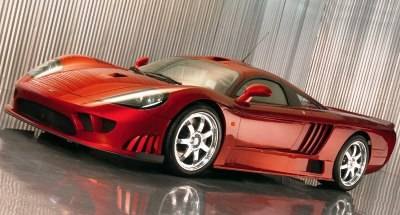
This a new concept BATMOBILE,very nice and you know believe or not batmobile lose with F1
MOr3
Friday, January 23, 2009
CAR audio
MSRP: $89.95 The aluminum hard-dome tweeter sits on a static pole in the center of the driver. As a crossover, it uses a subpar electrolytic capacitor for a -6dB highpass while the woofer rolls off naturally. Interestingly, the woofer uses a 3-ohm voice coil, probably for efficiency reasons, so make sure your amplifier can handle the impedance if you're wiring multiples. Also be aware that the frame is of the 165mm variety so it may not drop into the factory speaker holes in some vehicles. The manual is very thorough, but the illustrations were a little difficult to understand. The system comes with speaker grilles, wire, a cutout template, and a couple of stickers if you'd like to flaunt your PowerBass purchase. Listening Unconventional Yet Stunning For this review, Morel sent a product that's certainly unconventional in mobile audio. The Integra Ovation XO 6 is what is referred to as a point source system. Although it could be viewed as a coaxial since each speaker consists of a tweeter and a woofer, and the similar attachment point of the tweeter placing it within the woofer's cone, point source speakers carry a fundamental difference. Whereas the tweeter in a coaxial speaker sits above the cone up on a standoff typically originating from the center of the woofer's voice coil, the tweeter in a point source speaker is recessed so that its diaphragm is aligned with the woofer cone, thereby creating a single point of origin for sound to be reproduced. This speaker alignment, along with a phase correct crossover, virtually eliminates time domain errors that are a byproduct of the speakers being offset from each other. In other words, the speakers perform as one transparent unit. The Integra Ovation XO 6 is built on Morel's aluminum die-cast Uniflow basket used by many of the company's high-end components. Mechanical energy for the woofer is supplied by an internal hybrid motor structure employing a pair of neodymium magnets, used to motivate the oversized 2.1-inch aluminum Hexatech voice coil (honeycomb-shaped wire that reduces air gaps in the windings, thus increasing efficiency). The voice coil, via its aluminum former, attaches to a composite cellular fiber cone that's terminated at the edge by a high-loss rubber surround. Seated within the leading edge of the woofer's voice coil former is the tweeter. It sports a 28mm (1.1-inch) Acuflex-coated soft dome and is powered by its own neodymium motor. Out front it employs a controlled dispersion cup surrounding the dome, which should help maintain phase linearity and control any negative interaction from the woofer cone (particularly while it plays lower frequencies). PowerBass L-6502 - Fullrange System Roundup
 Power Bass L-6502
Power Bass L-6502
PowerBass went the extra mile to make a set of speakers that really stands out. The first thing I noticed was my reflection in the polished black, advanced-injection Zirconium polypropylene cone. Flipping the driver over I caught an eyeful of the stamped steel basket that was brushed to look stainless and clearcoated for protection. It holds the PowerBass insignia in two of its legs, as does the rubber motor boot. Even the thick, high-gloss sticker at the rear of the motor is stylish. Impressive... so far.
Overall, I was rather pleased with the response of the L-6502's. Tonally, the system remained pretty linear throughout its usable frequency range, and its bass output was average. That alone is enough to satisfy most consumers. However, if you are, or aspire to be, an audiophile, there were some areas I felt could use some improvement. The pianos in Coldplay's "Clocks" seemed to upset the tweeters which would create a buzzing overtone to the notes. I also noted a bit of sibilance to Phil Collins' vocals, and less than perfect imaging. Each of these is likely related to the poor choice of tweeter crossover I mentioned prior. That being said, most of us don't fit the critical audiophile category, and I can only conclude that the PowerBass L-6502 is an excellent sounding set for the money.
"Average" is half points possible SUBJECTIVE SCORE CHART Points Possible PowerBass L-6502 Sound Quality 5 3 Treble 5 3 Midrange 5 3 Bass 5 2.5 Value 5 4
Additional sizes: 4", 4x7, 5.25", 6.75", 6x8, 6x9Morel Integra Ovation XO 6 - Fullrange System Roundup

Morel Integra Ovation XO 6
MSRP: $599.95
Morel is to the mobile audio industry what Porsche is to the automotive market. It might seem like a bit of a stretch to compare these two brands, but when you look at the overall picture it's quite clear. Like Porsche, Morel has an expansive array of performance products to fit the needs of its customer, ranging from modestly priced to the extreme. Both companies also build products outside of the box, using less-than-conventional designs that yield stellar results. Yet regardless of price and design, both Porsche and Morel preserve signature traits in each of their products that make them stand out in their respected fields.
Clarion SRQ1630R
MSRP: $199.99
Taking it up a notch, Clarion enters the fray with a multi-axial 3-way system. Instead of a single tweeter sitting out front, the SRQ1630R uses a 3/4-inch silk-dome midrange and a 5/16-inch dome tweeter to complement the woofer. While the main driver is said to be a 6.5-incher, its large mounting flange requires it use a slightly smaller cone than others in this group. The cone is derived of TM-MIPP (titanium metallized mica-injected polypropylene), which gives it the look of brushed titanium. Holding everything together is a generic-looking stamped steel basket with multiple mounting holes that Clarion claims to be GM fit. Clarion also provides a pair of adapter plates designed to fit Chrysler vehicles, wire, and a pair of two-piece grilles (these can be mounted with or without the wire mesh) in case you decide to make your own mounting provisions.
The manual? Well, let's just say Clarion was nice enough to supply some information on the outside of the packing box, which includes speaker specs, a mounting template and a non-descript wiring diagram. The only paperwork you'll find inside pertains to the warranty and product registration.
Listening
I kicked off my listening with "Everybody" by Raul Midon and followed it up with Toni Braxton's "Shadowless." Being similar-both use only the vocalist and guitar(s)-it was no surprise that I noted the same compromises with each artist, resulting in their upper frequency range being too airy, and the guitars tended to be a bit bright sounding. However, with Coldplay, the piano had surprising realism, and the guitar and bass really came to life with volume, even if a little thin at times. I also found the bass transients to be good with tracks such as "Boxenkiller," and pretty much anything that had bangin' percussions. In general I wasn't floored by the tonal linearity of the system, but the SRQ1630R proved to have good clarity and substantial bass response. Above all, I didn't find myself fatigued after my listening session, a trait that speaks for itself. At $200, they're pushing the envelope between price and performance, so take a listen to them and others before you commit.
| SUBJECTIVE SCORE CHART | ||
| Points Possible | Clarion SRQ1630R | |
| Sound Quality | 5 | 3 |
| Treble | 5 | 3 |
| Midrange | 5 | 3.5 |
| Bass | 5 | 3.5 |
| Value | 5 | 2.5 |
Additional sizes: 5x7, 6x8, 6x9
Steering wheel F-1
History steering

As recently as 1992, the steering wheel on a Formula 1 car was a relatively plain, straightforward piece of equipment, round in shape, with a metal plate at the centre to attach it to the steering column, and generally no more than three buttons – one for selecting neutral, one for releasing liquid through a tube in the helmet for the driver to replenish his fluid levels and one for the radio.
The advent of complex electronic systems in Formula 1 throughout the 1990s changed all that. McLaren engineer John Barnard was the first to introduce this system and enabled Nigel Mansell to shift gears without having to move a hand away from the steering wheel. It was introduced as a lever system at the back of the steering wheel. A pull on the left paddle will shift one gear down while the right paddle shifts up in a similar way. This eliminates the possibility of a driver missing a gear, therefore increasing the smoothness and improving the timing of gearshifts. Together with the introduction of semi-automatic gearboxes, this was one of the most changing introductions in the history of Formula One, especially on the driver's side. Later on, when left foot braking was introduced into Formula One, the clutch pedal was removed and replaced by a fully automatic hydraulic clutch, activated when the driver shifts gears on the steering wheel.
Engine mapping, traction control and the advent of launch control programs that optimised the race start procedure all required various buttons and toggle switches to enable the driver to fine-tune his car’s settings while on-track. Modern Formula 1 steering wheels are also equipped with a further lever clutch lever which the driver can use to declutch when standing still, such as during a pitstop or in the gravel to keep the engine running.
Construction
Today, a steering wheel is a complex electronic device that allows the driver to control a vast amount of carsettings. The teams often assign one engineer that is responsible for its electronics and the design so that the drivers can use it comfortably. For that reason, today's handles of a steering wheel are anatomically formed and made of hard rubber that provides extra grip for the driver's hands. The main part of the wheel however is constructed, just like almost every car part, of carbon fibre to reduce its weight. The pieces used today have a pricetag of around € 23.000 each.
The manufacture of any part on a Formula 1 car is a complex process, and the steering wheel is no exception. Various lightweight materials are used for its production, including the before mentioned carbon fibre and rubber with aluminium, titanium, steel and plastic. A complete steering wheel can take approximately 100 hours to produce from start to finish.
With the average steering wheel controlling as many as 12 separate parameters on the car, there is a large number of components, buttons and switches that have to be fitted during the manufacturing process – some 120 separate items in all. Yet, despite the myriad of materials and parts that make up each completed wheel, the weight of the finished unit, as fitted to the car, is just 1.3 kg.
During the season, a minimum of five steering wheels is constructed for each of the team’s two race drivers. Of these, three remain with the race team while two are held with the test team. In addition, on average two steering wheels have to be produced for each regular testdriver. Some teams, despite the cost of a steering wheel, remove the steering wheel from the car after a race win to put it in the team's collection as a memory to the win.
As imposed by FIA regulations, the steering wheel must be fitted with a quick release mechanism operated by pulling a concentric flange installed on the steering column behind the wheel.
The BMW Sauber 2006 steering wheel
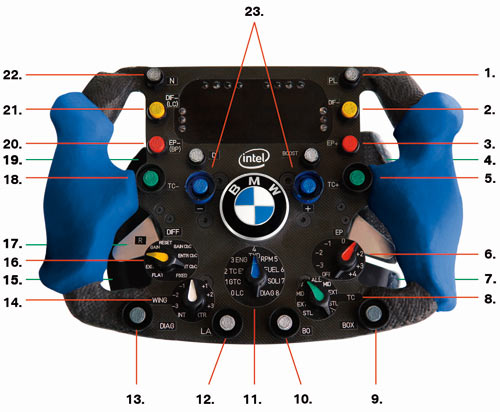
| 1. Pit lane speed limiter 2. Differential + 3. Engine push 4. Gear upshift 5. Traction control + 6. Engine push setting switch 7. Clutch lever 8. Traction control 9. Team info inlap 10. Burn out 11. Multifunctional switch 12. Lambda | 13. Diagnostic 14. Wing angle info switch 15. Clutch 16. Differential selective switch 17. Team radio 18. Traction control - 19. Gear downshift 20. Engine break 21. Differential - 22. Neutral 23. Display page change |
Ferrari 2002 steering wheel
After some time of consistency, the Ferrari steering wheel has been changed again at the beginning of the 2002 season and remained like that for the next couple of years.
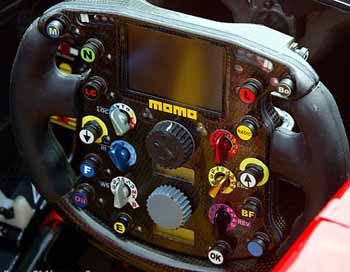
It's main buttons allow the driver to do the following:
- The big display in the center-top display all the information you can image: engine revs, laptimes, speed, gear, ...
- The green-black button N to put the gearbox in neutral
- The black-red LC button, to change setting of the launch control
- The red-black L button, to apply the speed limiter in the pit lane
- The yellow button radio is a switch for the onboard radio
- Buttons M and Bo on the top are multifunctional buttons for display adjustments
- The blue rotating button is to adjust the fuel-air mix in the engine
- The button under air-fuel allows the driver to regulate the braking pressure on the front and rear wheels
- The button above air-fuel permits adjustments to the power steering
- The 3 rotating buttons on the right are all for engine adjustments
JOKER'S car
Joker's Car In The Upcoming Batman Film, The Dark Knight
 Making a short detour from our everyday-car spy images, we discovered this scoop photo on the movie website, Latino Review. According to the author, Joker will use the purple-colored 30���s pick-up truck in the sequel of Batman Begins, ���The Dark Knight��� which is due for release in July 2008. True or not, the pick-up looks so out of place and messed up that we couldn't imagine anyone else driving it but Joker.
Making a short detour from our everyday-car spy images, we discovered this scoop photo on the movie website, Latino Review. According to the author, Joker will use the purple-colored 30���s pick-up truck in the sequel of Batman Begins, ���The Dark Knight��� which is due for release in July 2008. True or not, the pick-up looks so out of place and messed up that we couldn't imagine anyone else driving it but Joker.
BATMOBILE vs F1

Remember the Formula 1 car vs. Batmobile Tumbler pictures from last week? Well, the video is now finally available for your viewing enjoyment. Click here for first picture in gallery. To mark the release of the new Batman movie, “The Dark Knight” staring Christian Bale, the Dark Knight artwork will be displayed on the TF108s and the overalls of Jarno Trulli and Timo Glock, as well as the team’s motor home.
Porsche Carrera GT
Porsche Carrera GT
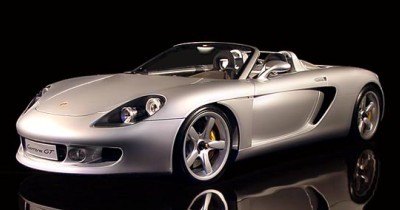
Top Speed: 209 mph
605 Horsepower
Porsche’s fastest, most attractive (and most expensive) car to date comes in at #9.
McLaren F1 and McLaren Mercedes SLR
McLaren F1
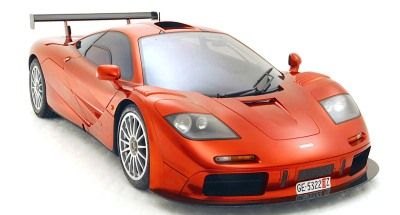
Top Speed: 240.14
620 Horsepower
Can you believe this? The McLaren F1 was made in 1994, 13 years ago, and it’s still one of the fastest cars in the world. This happens to be the first car on this list I would purchase if I had the cash. Then I’d buy the Koenigsegg.
McLaren Mercedes SLR
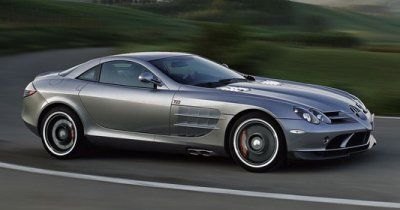
Top Speed: 207 mph
626 Horsepower
Thursday, January 22, 2009
DUPLICATE the dark knight
the dark knight replica
 Believe it or not, this staggering working replica of Batman’s current generation Batmobile Tumbler (see video here) was built from scratch in a house garage by Bob Dullam. Even more impressive is the fact that Dullam, who makes specialty costumes, props, and statues for a living, created the Tumbler without the use of blueprints as the only references he had were photos of the car that he downloaded from the internet.
Believe it or not, this staggering working replica of Batman’s current generation Batmobile Tumbler (see video here) was built from scratch in a house garage by Bob Dullam. Even more impressive is the fact that Dullam, who makes specialty costumes, props, and statues for a living, created the Tumbler without the use of blueprints as the only references he had were photos of the car that he downloaded from the internet.
 According to Dullam, the project cost him in materials somewhere between $50,000 and $70,000. As you can see in the pictures after the jump, Dullam also made a Batman suit to go with the car. And that’s not all as the talented builder said that he has already begun working on the Batpod from “Batman Begins” and “The Dark Knight”. Guess we all know who the real “Boy Wonder”…is! -Image gallery after the jump
According to Dullam, the project cost him in materials somewhere between $50,000 and $70,000. As you can see in the pictures after the jump, Dullam also made a Batman suit to go with the car. And that’s not all as the talented builder said that he has already begun working on the Batpod from “Batman Begins” and “The Dark Knight”. Guess we all know who the real “Boy Wonder”…is! -Image gallery after the jump
